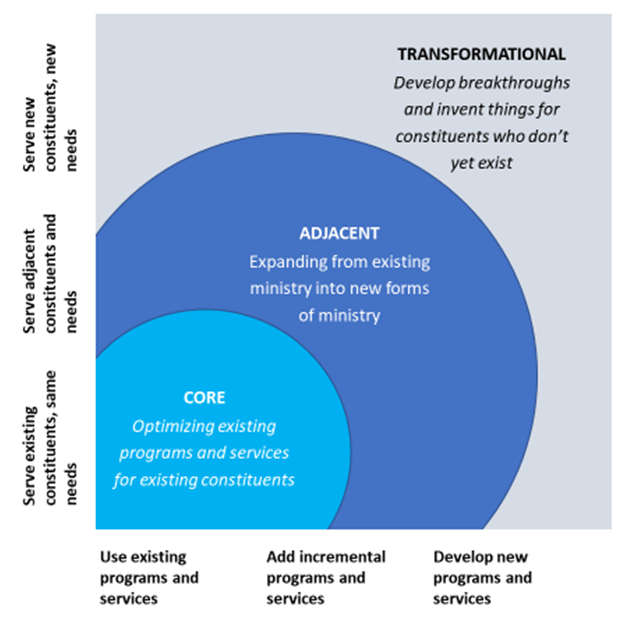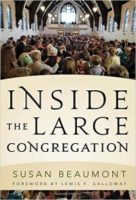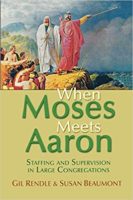
“We need to innovate” may be one of the most overused phrases addressing the future of the Church. We like to dream big dreams, but realistically, what can we accomplish with our limited resources and our members who dislike change? Which innovation efforts will help create and sustain a hope-filled future—and which will prove to be a poor investment of our time and resources?
The future of any congregation is neither completely open nor completely pre-determined. Instead, we face a corridor of potential, constrained by boundaries. A future not yet known but brimming with possibilities is bounded by limitations of the past and present. We only have so many resources and opportunities. It is false to think that nothing new is possible. It is just as false to pretend that everything is possible.
How Innovation Works
Markus F. Peschl, a Theory U scholar and professor, has developed the Innovation Zipper as a metaphor to illustrate how organizations learn from the future as it emerges:
- The present moment and the present circumstance are beginning points for getting in touch with potential. We are transformed or reshaped by our choices now and our interaction with the present environment.
- Our present state is the product of our interaction with our past environment.
- At any point in time, we have a limited number of possible decisions and options for ways we might transform our environment. We can discover our way towards a thriving future state, but we must get there in incremental steps.
- Each decision point creates a new “zipper-path” to the future, giving rise to a new set of “adjacent possibles”—a set of unique and novel pathways, yet to be constructed, that could be built on the existing structure.
- It is not possible to predict all possible outcomes. New possibilities emerge all along the way as the environment changes. We must give up on the idea of having a clearly defined goal or purpose for each innovation before starting to interact with the environment.
Innovation happens not by following a map or script, but by responding in each moment to a fresh set of adjacent possibles—the unique and novel outcomes that could be constructed from where we currently stand. This is so different from how congregations often think about their future and their planning work!
First Church, for example, is a declining congregation whose membership body is mostly people over the age of seventy. No young adults are in the congregation and only a few children, most of whom are grandchildren of long-time members. During a recent board retreat, leaders expressed a desire to grow and to make the church more attractive to “young people.” They began dreaming about new programs targeted at 20 to 35-year-olds.
The challenge: the current membership body doesn’t have anyone in that age group and no one with knowledge about how to do ministry with young adults. So members are considering fundraising to hire a young staff member to pursue this work on their behalf. Is this a productive area of innovation for First Church?
It would be difficult for First Church to launch a successful young-adult ministry from where they currently stand. There is a large disconnect between their present state and their desired future outcome—no way for the teeth of the zipper to connect. They would be wise to explore a more readily adjacent possibility. For instance, they might establish a relationship with the new 55+ housing complex opening a half-mile from their building. Gaining young adults is not the only pathway towards church vitality.
Discovering Adjacent Possibilities
An article from the Harvard Business Review, “Managing Your Innovation Portfolio” by Bansi Nagji and Geoff Tuff, describes three kinds of innovation work. “Core” innovation aims to improve what you are already doing, “Adjacent” innovation looks for ways to stretch what you are doing, and “Transformational” innovation breaks the mold more radically. The following matrix is adapted from the article:

At the lower left of the matrix are core innovation initiatives—efforts to make incremental changes to existing programs and ministries for existing constituents.
In the middle are adjacent innovations. An adjacent innovation involves leveraging something the congregation already does well to move into a new space.
At the opposite corner of the matrix are transformational initiatives, designed to create breakthrough offerings for brand new constituents—if not whole new ministries—to serve unknown constituents. These are the innovations that, when successful, make headlines.
Research showed that organizations that allocated about 70% of their innovation activity to core initiatives, 20% to adjacent ones, and 10% to transformational ones outperformed their peers, Nagji and Tuff report. (This research was largely conducted among businesses, so results for churches might be different.)
Transformation or Improvement?
Clearly, the Church needs transformative innovation to survive and thrive in the future. However, not every local congregation can or needs to take on radical transformative work. Most of those initiatives will fail. Instead, you should focus on growth into your adjacent possibilities.
Innovation isn’t a large and scary monster. Do something simple. Identify the next right thing. Just get clear about what you already do well and figure out how to expand your impact by meeting new needs, reaching new constituents or by expanding a core strength.
Susan Beaumont is a coach, educator, and consultant who has worked with hundreds of faith communities across the United States and Canada. Susan is known for working at the intersection of organizational health and spiritual vitality. She specializes in large church dynamics, staff team health, board development, and leadership during seasons of transition.
With both an M.B.A. and an M.Div., Susan blends business acumen with spiritual practice. She moves naturally between decision-making and discernment, connecting the soul of the leader with the soul of the institution. You can read more about her ministry at susanbeaumont.com.



